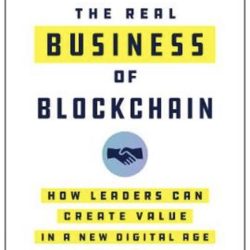How can blockchain be rescued from the trough of disillusionment?

Blockchain – which is widely regarded as the biggest revolution since the emergence of the internet – is currently in a dip, or the ‘trough of disillusionment’ as research and analysis firm Gartner calls it. The novelty and excitement have worn off, but there are no success stories yet either. This book explains once again what is so groundbreaking about blockchain and why it will revolutionize the field of supply chain management.
Just as we have become used to from Gartner’s analysts, this book begins with some impressive claims about how spectacular blockchain’s impact on supply chains will be. According to Gartner, blockchain will generate more than 3,000 billion (!) dollars’ worth of business value by 2030. If all transactions, from farm to fork, are stored securely and decentrally and made available to supply chain partners in a controlled manner, this will offer unprecedented opportunities.
In The Real Business of Blockchain, the authors David Furlonger and Christophe Uzureau describe the three phases in which the blockchain revolution will happen over the coming years – or rather, in which it is happening right now, because the first phase has already been completed. That was the phase in which we saw the initial pilots relating to various sub-elements of blockchain. The book gives a number of good examples of these, such as a project by Alibaba related to food traceability and one by Maersk in the area of visibility and transport documentation.
True blockchain philosophy
Gartner does not regard these initiatives as fully-fledged blockchain projects because they have been managed by a single company in a classically hierarchical way. In the next phase, which is where we are currently, we will see projects applying the true blockchain philosophy, i.e. based on a decentralized approach. Crucial here is the definition of a new type of cryptocurrency allowing goods, services and information to be ‘traded’. There is an interesting chapter on ‘tokenization’ that explains why traditional payment systems are unsuitable for this.
Intelligent heating system
When all the preconditions have been met, the way will be clear for the third and final phase of the blockchain revolution. In this phase, transactions will be handled by computers and devices rather than people doing business with each other. The authors predict that this will add a new dimension to the Internet of Things. In one example, they mention a smart heating system that autonomously ‘negotiates’ the price for the energy it needs with the solar panel system on the neighbour’s roof. New decentralized business models will also emerge relating to the sharing economy, such as Zipcar in the mobility arena and LO3 in the energy sector.
According to Gartner, the expectations around blockchain were sky-high but the technology is in a temporary dip. Thanks to well-written books like this one, which shows how companies can take the next step, that dip is unlikely to last much longer.
The Real Business of Blockchain (2019), Furlonger & Uzureau (Gartner). Harvard Business Review Press, 257 pages, €27.99
![]()










